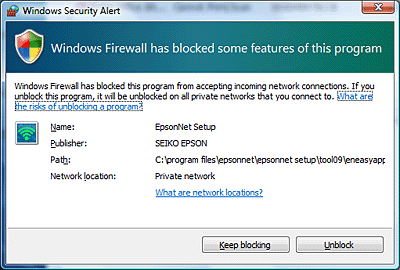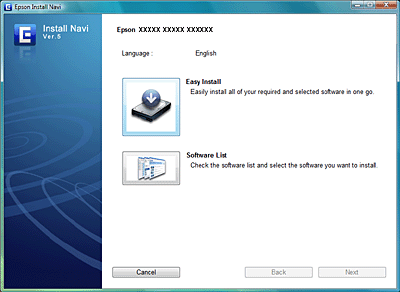 |
 |
|
||
 |
||||
Using the Printer from a Second Computer
This section describes how to use the printer from a second or additional computer. Set by following the on-screen instructions from the installer (Install Navi) on the printer software CD. For Macintosh, you need to register the printer to the computer after installing the software.
 Note:
Note:|
If the security alert screen for your OS or the application appears, click Unblock. Do not click Keep blocking or Ask Me Later.
Do not click Keep Blocking, Block, or similar command on commercially available security software screen. Depending on the commercially available security software used, the above procedure may not establish a connection. In this case, temporarily exit the security software and then use the printer’s software.  If you want to make network settings, remove the memory card from the printer before beginning setup.
|
 |
Check that the printer is turned on.
|
 |
Insert the software CD-ROM into the CD-ROM drive.
For Mac OS X, double-click the Mac OS X icon. |
 Note:
Note:|
If the installation screen does not automatically appear in Windows, double-click the CD-ROM icon in Computer (or My Computer) from the Mode pop-up menu.
|
 |
Click the Easy Install icon button.
|

 |
Read the License Agreement carefully.
|
 |
Select Agree, then click Next.
|
 |
If you want to install software from the Recommended list, select the check box to the left of the software name.
All software from the Required list is installed. |
 |
Click Install.
|
 |
Select Wi-Fi, or Ethernet Network connection, and then click Next.
For Type B printers, select Ethernet Network connection, and then click Next. |
 |
Select No: Additional computer setup, and then click Next.
|
 |
Follow the on-screen instructions.
|
 Note:
Note:|
When installing the necessary software, you can use the OS functions or make the settings manually. For details, see Manual Setup Procedure.
|
Adding a printer (for Mac OS X)
After installing the software, you need to add the printer to the Mac OS X printer list to use the printer.
 |
Double-click the Macintosh HD icon.
|
 Note:
Note:|
If the Macintosh HD icon name has been changed, double-click the icon of the drive running Mac OS X.
|
 |
Double-click the Applications folder, Utilities folder, then Printer Setup Utility icon.
|
 |
If the Printer List screen or a message screen appears, click Add.
|
 |
Select the printer from the list, then click Add on the Printer Browser screen.
|
For Mac OS X 10.3, select Rendezvous on the Printer List screen, click the printer, and then click Add.
 Note:
Note:|
To print via Rendezvous (Mac OS X 10.3)/Bonjour (Mac OS X 10.4 or later), the printer and computer need to automatically obtain an IP address via the DHCP function. If a unique IP address is assigned to the printer, select EPSON TCP/IP (or TCP/IP).
|
For Mac OS X 10.5: Add the printer to the application’s File menu.
 |
In Finder, or from an application such as TextEdit, select File and then Print.
|
 |
Select Add Printer from the Printer list.
|
Connecting the scanner
Set the EPSON Scan connection and check the performance.
 |
For Windows: Click the Start button (or Start), Programs (or All Programs), EPSON, EPSON Scan, and then EPSON Scan Settings.
For Macintosh: Double-click Macintosh HD, Applications, Utilities and then EPSON Scan. |
 Note:
Note:|
If the scanner is listed but cannot be selected immediately after the EPSON Scan Settings screen appears, wait for the search to end.
For Windows Vista: Click Allow in the User Account Control dialog box.
|
 |
Verify that the scanner is selected, select Network and then click Add.
|
 |
Enter the Scanner Name, and wait for the search to end.
|
 |
Select the scanner’s IP address, then click OK.
|
 Note:
Note:|
If the address does not appear, check the connection and click Retry, or click Enter address and directly enter the IP address. Entering the IP address directly disables the IP address auto-follow function.
|
 |
Select the scanner, then click Test.
|
 |
Verify that The connection test was successful and the scanner name are displayed, then click OK.
|
